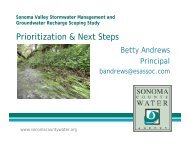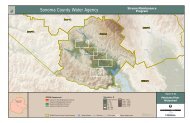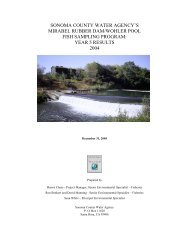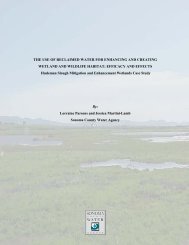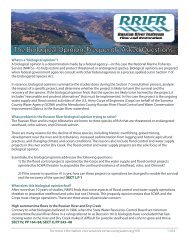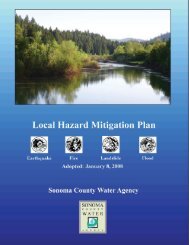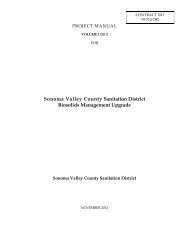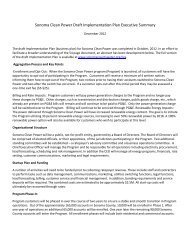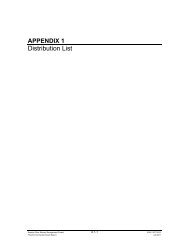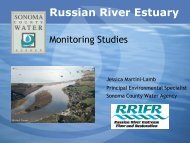Chapter 3 Water Reuse - Sonoma County Water Agency - State of ...
Chapter 3 Water Reuse - Sonoma County Water Agency - State of ...
Chapter 3 Water Reuse - Sonoma County Water Agency - State of ...
You also want an ePaper? Increase the reach of your titles
YUMPU automatically turns print PDFs into web optimized ePapers that Google loves.
<strong>Water</strong> Smart Development Guidebook<br />
<strong>Chapter</strong> 3. <strong>Water</strong> <strong>Reuse</strong><br />
campus. MBR systems are capable <strong>of</strong> treating wastewater to Title 22 standards. The resulting<br />
recycled water can be used within the same building for non‐potable uses such as toilet flushing,<br />
landscape irrigation, and building cooling. Although MBR systems are not common, there may<br />
be future opportunities for facilities in <strong>Sonoma</strong> <strong>County</strong> to use MBR systems for wastewater<br />
treatment and water reuse.<br />
In a typical MBR system, wastewater from a building’s toilets, showers, washing machines, and<br />
sinks is piped to the basement <strong>of</strong> the building where it is held in storage and settling takes place.<br />
Biosolids are directed to the municipal sanitary sewer system. The wastewater then passes<br />
through an MBR package unit that uses aerobic and anaerobic biological treatment in<br />
conjunction with micr<strong>of</strong>iltration to purify and filter the wastewater. From the MBR, the water is<br />
disinfected using a UV disinfection process. Chlorine is added before distribution to ensure<br />
residual disinfection throughout the distribution system. At this point, the treated water meets<br />
Title 22 standards for water reuse and is pumped back into the building or pumped to adjacent<br />
buildings for use as irrigation or cooling tower process water. Any water that is produced<br />
beyond demand is routed to the sanitary sewer for disposal. An odor control unit is necessary<br />
to eliminate treatment‐related odors before releasing air to the atmosphere. This treatment<br />
process is illustrated in Figure 3‐3.<br />
In most cases <strong>of</strong> in‐building water recycling, the amount <strong>of</strong> wastewater supplied to the system<br />
will exceed the demand for recycled water in the same building. Excess waters can be<br />
distributed to adjacent areas or discharged to the sanitary sewer.<br />
Figure 3‐3: Membrane Bioreactor Treatment Process<br />
<strong>Sonoma</strong> <strong>County</strong> <strong>Water</strong> <strong>Agency</strong><br />
May 2011 3‐29




